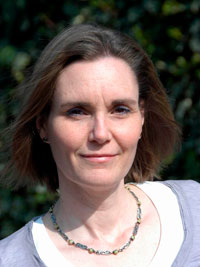
Welcome to the ezine produced by SGI Buddhists that prompts the positive, kindles the constructive, highlights the hopeful and leaves you feeling - well, up!

 Imagine being in your female prime of life and then succumbing to a little-known condition where food and drink is an unmitigated minefield and a social life is a struggle, let alone intimate relationships.
Imagine being in your female prime of life and then succumbing to a little-known condition where food and drink is an unmitigated minefield and a social life is a struggle, let alone intimate relationships.
In 1998, Elspeth Scott, an art therapist and textile print designer developed a painful illness known as interstitial cystitis / bladder pain syndrome at the age of thirty one for which there was, and continues to be, no cure available through conventional medicine.
Unlike common cystitis, no bacteria are found to be present in a urine test and the burning pain is caused by inflammation of tissues in the lining of the bladder.
There followed at least four years of gradually worsening symptoms that at first appeared as fairly typical female complaints: cystitis and urethritis for which she was prescribed repeated doses of antibiotics. Elspeth had also taken tetracycline for skin problems in her early twenties and evidence suggests there is a strong link between the overuse of antibiotics and a compromised immune system.
She has now written a wonderful guide entitled The Brightness of Healing: A Handbook on Healing a Painful Bladder and Maintaining a Healthy Body. In it she provides answers to the problem that she courageously went out and found for herself in her determined bid to cure herself, once and for all, of this debilitating and socially-arresting illness.
At the onset she started to notice reactions to various chemicals: a heightened sensitivity to toxins in everyday substances, including soaps, deodorants, perfumes and cigarette smoke. Alongside these, Elspeth also experienced other changes in response to the chemical dyes she was using in her silk painting. A moth infestation at home led to the use of several cans of a pesticide spray that contributed further, while a friend's wedding in Guernsey was spoiled by uncharacteristic lethargy and low spirits. The final straw was when, having drunk a half pint of Guinness following a trip to the cinema, she woke up the next morning with a pain in her bladder that would prove intolerable and would not go away. Other recurrent symptoms at the time included sore throats, headaches, constipation and bloating. Knowing what food was safe to eat was complicated as some types of food would trigger more pain and drinking alcohol was impossible.
At this point she was referred to a specialist but was again offered long-term antibiotic treatment. Bravely, she decided she had to go it alone in her mission to fully recover, although friends and family were unconvinced as they conventionally assumed, understandably, that the medical specialists knew best.
In the mid 90s alternative health treatments were still perceived as somewhat wacky, although now treatments like acupuncture, based on Ancient Chinese medicine, are prescribed on the NHS and health-food shops are on every high street. Because Elspeth's health and social life had worsened dramatically, she investigated a range of treatments including acupuncture, Reiki, homeopathy, and reflexology, alongside Chinese herbal medicine. In her book she sifts through many alternative treatments describing what worked best for her. She pinpoints naturopathy and kinesiology as particularly helpful, alongside diet and life-style changes. One of her first investments was a water distiller as regular tap water also contributed to the pain that she was experiencing.
For the first time, at her naturopath's clinic, she saw her fresh urine under a microscope showing bacteria, fungi and detached skin from her bladder. Interestingly, the naturopath told her that this crucial information can be lost in the time it takes for a urine sample to reach a hospital testing lab.
She also learned all about Candida Albicans, a problem in itself, let alone combined with interstitial cystitis. Basically an overgrowth of a parasitic form of yeast, Candida can thrive in a body with a weakened immune system, causing other health problems that are often attributed to something else. This newfound knowledge confirmed her belief that treating an isolated part of the body, in her case her bladder, was counter-intuitive and she needed to treat her body, mind and spirit holistically.
An anti-candida diet, with probiotics and other 
Her spiritual life also flourished during this period. The daughter of a Church of England vicar, she had always been spiritually inclined but, whilst looking for ways to get better she discovered Nichiren Daishonin's Buddhism. This daily practice focuses on an inner and outer transformation called human revolution; unsurprisingly this added fuel to her healing mission.
When Elspeth re-visited her NHS specialist to share her good news that she was now fully recovered, he told her that her illness had only gone into remission. She strongly disagrees and that is partly what motivated her to write this book - to offer practical help, hope and solutions to the many thousands of female sufferers out there.
Elspeth now embodies glowing health. She is an inspiration and a much needed voice in the recognition of holistic health as a viable alternative form of treatment.
The Brightness of Healing: A Handbook on Healing a Painful Bladder and Maintaining a Healthy Body is available from www.brightnessofhealing.com and on Amazon for £6.99.
Photograph by Simon Addinsell, www.addinsell.com

